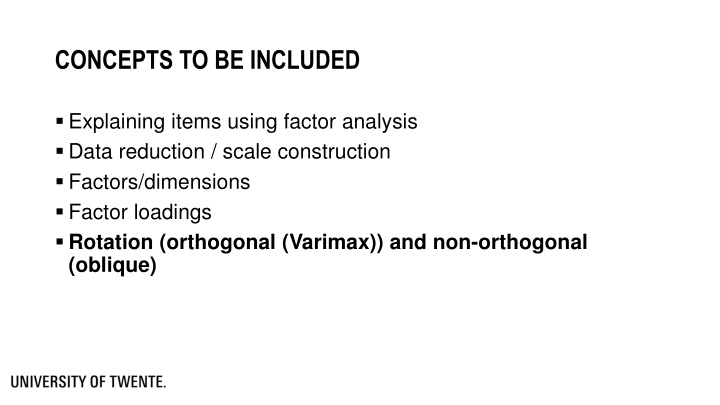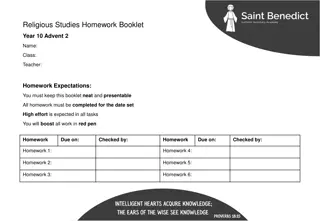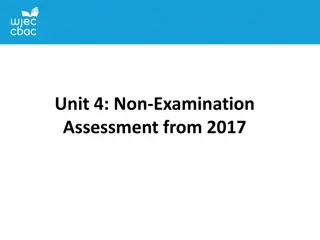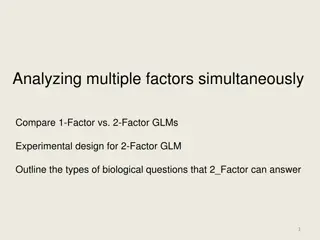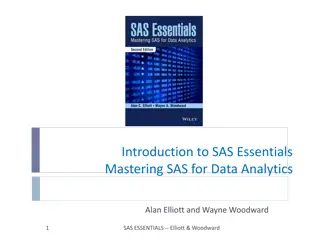Mastering Factor Analysis: Key Concepts and Interpretations
Delve into the realm of factor analysis with a focus on data reduction, scale construction, factor loadings, and rotation techniques like Varimax. Gain insights on interpreting factor loadings and understanding the relationship between items and factors through illustrative examples and factor matrices.
Download Presentation

Please find below an Image/Link to download the presentation.
The content on the website is provided AS IS for your information and personal use only. It may not be sold, licensed, or shared on other websites without obtaining consent from the author.If you encounter any issues during the download, it is possible that the publisher has removed the file from their server.
You are allowed to download the files provided on this website for personal or commercial use, subject to the condition that they are used lawfully. All files are the property of their respective owners.
The content on the website is provided AS IS for your information and personal use only. It may not be sold, licensed, or shared on other websites without obtaining consent from the author.
E N D
Presentation Transcript
CONCEPTS TO BE INCLUDED Explaining items using factor analysis Data reduction / scale construction Factors/dimensions Factor loadings Rotation (orthogonal (Varimax)) and non-orthogonal (oblique)
AIM Interpreting factor loadings after rotating factors/dimensions in exploratory factor analysis
EXAMPLE: PERSONALITY ITEMS Even minor annoyances can be frustrating to me Sometimes I feel completely worthless I really enjoy talking to people I often try new and foreign foods I try to be courteous to everyone I meet Strongly Disagree 0 Disagree Neutral Agree Strongly agree 4 1 2 3
MANY ITEMS, SMALLER SETS OF FACTORS Item 1 Item 2 Item 3 Item 10 Item 11 Item 20 Item 31 Item 32 Item 33 Factor 1 Factor 2 Factor 3 ETC Factor 4 Factor 5
Factor loadings FACTOR MATRIX Fact 1 Fact 2 Fact 3 Fact 4 Fact 5 Fact 6 Fact 7 Fact 8 Fact 9 Item 1 Item 2 Item 3 Item 4 Item 5 Item 6 Item 7 Item 8 Item 9
SCREE PLOT Eigenvalue Elbow criterion: selecting factors on the steep part of the scree plot Kaisers criterion: select factors based on Eigenvalue > 1 1 Factor 2 3 4 1 Etc
INTERPRETING FACTOR LOADINGS Non-rotated (initial) factor loadings are hard to interpret First factor has highest factor loadings Last selected factor has lowest factor loadings Rotation is a way to facilitate the interpretation of the relationship between items and factors
ROTATION IN FACTOR-ANALYSIS After the extraction of factors, rotation can be used to relate some items to one dimension and other factors to another dimension. This is done by giving HIGH factor scores for a specific dimension and LOW factor scores for the another dimension. Two ways to do that: factors are assumed to be NOT related (orthogonal: varimax) factors are assumed to be related (non-orthogonal: oblimin)
ROTATED FACTOR MATRIX (VARIMAX) Fact 1 Fact 2 Fact 3 Item 1 Item 2 Item 3 Item 4 Item 5 Item 6 Item 7 Item 8 Item 9 Rotated factor loadings
SOME PATTERNS OF ROTATED FACTOR LOADINGS Each item loads positively on one factor and hardly on other factors
ROTATED (PATTERN) FACTOR MATRIX (VALUES -0.3 TO +0.3 LEFT OUT) Fact 1 Fact 2 Fact 3 Item 1 0.771 Item 2 0.726 Item 3 0.587 Item 4 0.738 Item 5 0.727 Item 6 0.540 Item 7 0.533 Item 8 0.668 Item 9 0.652
SOME PATTERNS OF ROTATED FACTOR LOADINGS Each item loads positively on one factor and hardly on other factors Each item loads strongly on one factor and hardly on other factors, but all factor loadings for one factor are negative
ROTATED FACTOR MATRIX (VALUES -0.3 TO +0.3 LEFT OUT) Fact 1 Fact 2 Fact 3 Item 1 0.771 Item 2 0.726 Item 3 0.587 Item 4 - 0.738 Item 5 - 0.727 Item 6 - 0.540 Item 7 - 0.533 Item 8 0.668 Item 9 0.652 No problem at all, make sure you interpret the factor correctly: High item scores; low factor scores Example: I often try new and foreign foods (high), Low values of the factor mean: very open , high values of the factor means: very closed
SOME PATTERNS OF ROTATED FACTOR LOADINGS Each item loads positively on one factor and hardly on other factors Each item loads strongly on one factor and hardly on other factors, but all factor loadings for one factor are negative Each item loads strongly on one factor and hardly on other factors, but some factor loadings for one factor are negative
ROTATED FACTOR MATRIX (VALUES -0.3 TO +0.3 LEFT OUT) Fact 1 Fact 2 Fact 3 Item 1 0.771 Item 2 0.726 Item 3 0.587 Item 4 - 0.738 Item 5 - 0.727 Item 6 0.540 Item 7 0.533 Item 8 0.668 Item 9 0.652 No problem, items probably indicate opposite things: For some item scores; low factor scores Example(openness): I have little interest in speculating on the nature of the universe I am intrigued by the patterns I find in art and nature
SOME PATTERNS OF ROTATED FACTOR LOADINGS Each item loads positively on one factor and hardly on other factors Each item loads strongly on one factor and hardly on other factors, but all factor loadings for one factor are negative Each item loads strongly on one factor and hardly on other factors, but some factor loadings for one factor are negative Some items loads on one factor, but the other items do NOT load highly on a second factor
ROTATED FACTOR MATRIX Fact 1 0.63 0.47 0.45 0.39 0.12 0.21 Fact 2 0.14 0.24 0.22 0.25 0.20 0.18 Fact 3 Item 1 Item 2 Item 3 Item 4 Item 5 Item 6 Item 7 Item 8 Item 9 In this case it MAY be that a simpler interpretation can be found assuming the factors are correlated Use another rotation method!
THIS MICROLECTURE Interpreting factor loadings after rotating factors/dimensions in exploratory factor analysis
